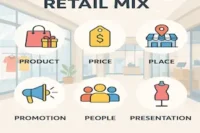What Is Same Store Sales? Why It’s Important Businesses?
Published: 24 Mar 2025
Same-store sales, also known as SSS, are simply a way to measure the performance of your older stores over time.
It looks at sales from stores that have been open for at least a year to see if they’re growing or slowing down.
Here’s a complete guide on what the same-store sales is, how to calculate it, why it’s important, and what are its key pros and cons.
What Is Same Store Sales?
Same Store Sales (SSS) is a key retail metric used to measure the performance of stores that have been open for at least a year.
It compares sales from these established stores over a specific period, such as a month, quarter, or year, to assess growth or decline.
By focusing only on older stores, SSS eliminates the impact of new store openings, providing a clearer picture of organic growth and operational efficiency.
For example, if a store generated $200,000 in sales last year and $220,000 this year, it shows a 10% increase in the same-store sales (SSS).
This metric is essential for retailers and restaurants to evaluate trends, measure the success of their marketing strategies, and make data-driven decisions for long-term success.
How Are the Same Store Sales Calculated?
Same-store sales (SSS) are calculated using a simple formula that compares sales from stores open for at least one year.
To calculate your store SSS, first of all
- Identify the time: Choose the time frame you want to compare, such as this year vs. last year or this quarter vs. the same quarter last year.
- Secondly, Gather Sales Data from stores that have been open for at least 12 months. Exclude sales from new stores.
And in the third step, apply this formula:
- SSS = Current Period Sales – Prior Period Sales) ÷ Prior Period Sales] × 100.
Now let’s take an example of it.
Let’s say one of my e-commerce stores generated $500,000 in revenue last year and $600,000. So according to the formula
- $600,000 – $500,000 ÷ $500,000 × 100 = 20
So this calculation shows my e-commerce store has grown 20% more than the previous year, it’s great 👍
Why Is Same Store Sales Important?

Same-store sales (SSS) is a critical metric for businesses because it measures the growth or decline of sales in established locations over time.
Focusing on stores open for at least a year, provides a clear picture of organic performance, excluding the impact of new store openings.
- It helps businesses understand if their strategies are working. For example, if SSS is growing, it means existing stores are performing well.
- Investors use same-store sales to evaluate a company’s health. Consistent growth in SSS is often seen as a sign of strong management and customer loyalty.
- It allows businesses to compare performance across locations. This helps identify which stores are thriving and which need improvement.
- SSS highlights trends in customer behavior. For instance, a drop in SSS might indicate changing preferences or increased competition.
- It provides actionable insights for decision-making. Businesses can use same-store sales (SSS) data to adjust pricing, marketing, or inventory strategies.
- Unlike total sales, SSS focuses on real growth. This makes it a more reliable indicator of long-term success.
Factors Affecting Same Store Sales.

Same-store sales (SSS) can be influenced by a variety of factors, both internal and external.
Understanding these factors helps businesses identify challenges and opportunities to improve performance.
Here are some of the key factors affecting same-store sales.
- Changes in customer preferences can impact SSS. For example, shifts toward online shopping or demand for sustainable products may reduce in-store sales. In that case, expanding your business online or offering eco-friendly options can help attract more customers.
- Economic conditions, such as inflation, recession, or changes in disposable income, can also impact consumer spending habits. During tough times, focusing on value-for-money products or promotions can keep customers coming back.
- Poor customer service or negative experiences are also key factors affecting same-store sales. So to make your store always growing, make sure to train your staff properly to provide excellent service and resolve customer complaints quickly. This approach will build customer loyalty and improve sales.
- Increased competition from nearby stores or new market entrants can draw customers away, reducing foot traffic. Differentiating your brand with unique products, better quality, or exceptional service can help you stand out.
- Pricing strategies are also key affecting factors for same-store sales. If your products have higher price tags than your customers, then don’t expect more for future growth.
- Seasonal trends and fluctuations, such as holiday rushes or slow summer months, can cause significant variations in sales. Planning promotions or special events during slow periods can help maintain steady revenue.
- External factors like extreme weather events, supply chain disruptions, or global crises can unexpectedly impact store performance. Building a flexible business model and having contingency plans in place can help you adapt to unforeseen challenges.
So guys these were the primary factors that affect same-store sales (SSS).
By recognizing these factors and limitations, businesses can better interpret SSS data and develop strategies to address challenges while leveraging growth opportunities.
Same Store Sales VS. Total Sales
Both same-store sales and total sales measure a company’s revenue performance but differ a little bit in their focus.
For example, Same-store sales focus on revenue from locations that have been open for at least one year or more.
It provides insight into organic growth and the effectiveness of operations, marketing, and customer retention at established stores.
On the other hand, Total sales include revenue from all stores, both existing and newly opened, offering a broader view of overall performance and expansion efforts.
Comparing the two helps distinguish whether growth is driven by improving existing store performance or by opening new locations.
This analysis is essential for understanding a company’s financial health, growth strategy, and long-term sustainability.
Hey My Dears
So today we’ve deeply understood what same-store sales (SSS) are and Why they are important.
They provide a clear picture of organic growth by focusing on revenue from established stores, helping us gauge customer loyalty, operational efficiency, and the effectiveness of strategies within existing locations.
By comparing SSS to total sales, we can better assess whether a company’s growth is driven by improving its current footprint or simply expanding through new stores.
This understanding is crucial for making informed decisions about a company’s financial health and long-term potential.
Thanks for joining me in exploring this key metric—until next time!

- Be Respectful
- Stay Relevant
- Stay Positive
- True Feedback
- Encourage Discussion
- Avoid Spamming
- No Fake News
- Don't Copy-Paste
- No Personal Attacks



- Be Respectful
- Stay Relevant
- Stay Positive
- True Feedback
- Encourage Discussion
- Avoid Spamming
- No Fake News
- Don't Copy-Paste
- No Personal Attacks



